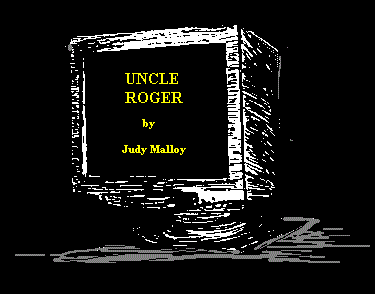|
Uncle Roger by Judy Malloy
Originally authored for command line computer platforms, the three files of Uncle Roger were created with hundreds of lexias -- screen sized units of text that can either stand by themselves or be combined with other lexias to create a coherent narrative. The author's vision was to create a work of electronic literature in which the reader would recreate a fictional environment by repeatedly plunging into a database and emerging with narrative information. Each lexia was written as a scene that could either stand by itself or be combined with other lexias to create a narrative. Scene-based Renaissance comedy was influential not only in the writing but also in the idea of beginning a story in the online equivalent of a town square. Mirroring the 1980's transitioning of computer culture -- as does the choice of hacker's BASIC as a programming language -- the narrative is set in Silicon Valley in the era of semiconductor "chip" wars, when the race for who could make the fastest chip heralded the era of personal computer culture. There is no treasure,no mystery,no maze in Uncle Roger. Instead, the quest on which the reader embarks is to explore a diffuse work of narrative poetry. In the first file of Uncle Roger, "A Party in Woodside", during a long, mostly sleepless night-after, a party in a Silicon Valley bedroom community is remembered intermittently, interspersed with dreams and nightmares. Because nights of insomnia often follow unsettling experiences -- replaying them as dream and memory fragments -- such long and sleepless nights approximate nonlinear narratives. The compressed time and place of a party is also important in the hypertextual build-up of narrative detail. As at any party, the reader meets some people but not others, observes some events but not others. A story is slowly revealed. In Silicon Valley, things do not happen simply and clearly. In File 2 of Uncle Roger, "The Blue Notebook", parallel yet intertwining narratives advance the story in sometimes conflicting ways -- reflecting the increasing complexity of the narrative. In File 3, "Terminals", generative hypernarrative simulates the diffuse, unsettled quality of the narrator's changing life; the reader has no idea what will happen next, and unexpectedly an unpredictable relative is the deus ex machina. Thirty-one years after it was first published on Art Com Electronic Network, Uncle Roger remains important, not only as a pioneering work of computer-mediated hypertext literature, but also as the first full length work of electronic literature narrative published online.
History and Documentation Please note that the authorized text for this work is the existing web version, first published in 1995 and tweaked in 2012. The DOSBox emulation version uses the original 1986 Apple BASIC program as it was modified for IBM PC computers in 1988. The program and look and feel of the emulator version are nearly the same as the original BASIC program, but for consistency, the emulator version uses the authorized text as it was modified 22 years ago in 1995 and mildly tweaked in 2012. Last modified on June 30, 2017 
|
